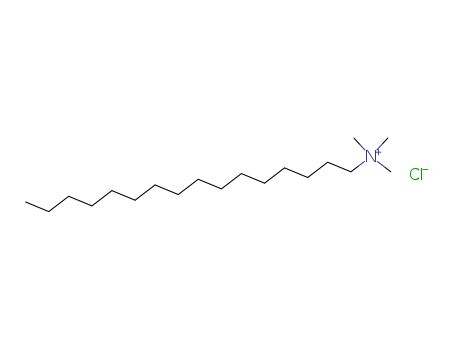Your Location:Home > Products > Other > N-Hexadecyltrimethylammonium chloride



CasNo: 112-02-7
MF: C19H42N.Cl
Appearance: White or yellowish paste or solid
|
Definition |
ChEBI: The organic chloride salt of cetyltrimethylammonium. |
|
General Description |
Colorless to pale yellow liquid with an odor of rubbing alcohol. Floats or sinks in water. |
|
Reactivity Profile |
Acidic salts, such as N-Hexadecyltrimethylammonium chloride, are generally soluble in water. The resulting solutions contain moderate concentrations of hydrogen ions and have pH's of less than 7.0. They react as acids to neutralize bases. These neutralizations generate heat, but less or far less than is generated by neutralization of inorganic acids, inorganic oxoacids, and carboxylic acid. They usually do not react as either oxidizing agents or reducing agents but such behavior is not impossible. Many of these compounds catalyze organic reactions. |
|
Hazard |
A poison by ingestion and skin contact. |
|
Health Hazard |
Ingestion may produce toxic effects. Contact with eyes or skin may cause severe damage. |
|
Flammability and Explosibility |
Nonflammable |
|
Purification Methods |
Crystallise the chloride from acetone/ether mixture, EtOH/ether, or from MeOH. [Moss et al. J Am Chem Soc 109 4363 1987, Beilstein 4 IV 819.] |
InChI:InChI:1S/C19H42N.ClH/c1-5-6-7-8-9-10-11-12-13-14-15-16-17-18-19-20(2,3)4;/h5-19H2,1-4H3;1H/q+1;/p-1
Cationic micelles speed addition of cyan...
-
The present invention relates to stable ...
The invention relates to mixtures compri...
The present invention relates to active ...
A dental composition for oral use, conta...
methylene chloride

N,N-dimethylhexadecylamine

cetyltrimethylammonium chloride
| Conditions | Yield |
|---|---|
|
With Petroleum ether; at 80 ℃;
|
1-Chlorohexadecan

trimethylamine

cetyltrimethylammonium chloride
| Conditions | Yield |
|---|---|
|
With ethanol; at 100 - 105 ℃;
|
|
|
In isopropyl alcohol; for 72h; Heating;
|
methylene chloride
N,N-dimethylhexadecylamine
1-Chlorohexadecan
trimethylamine
methylene chloride
2-naphthalenesulfonate
1,5-bis(2,6-dimethoxyphenyl)-1,4-pentadiene-3-one
1,5-bis-(4-dimethylamino-phenyl)-penta-1,4-dien-3-one